Research Projects
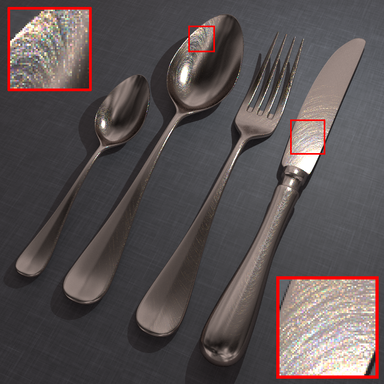
Rendering Specular Microgeometry with Wave Optics
Simulation of light reflection from specular surfaces is a
core problem of computer graphics. Most existing solutions
either make the approximation of providing only a large-area
average solution in terms of a fixed BRDF (ignoring spatial
detail), or are based only on geometric optics (which is an
approximation to more accurate wave optics), or both. We
design the first rendering algorithm based on a wave optics
model, but also able to compute spatially-varying specular
highlights with high-resolution detail. We compute a wave
optics reflection integral over the coherence area; our
solution is based on approximating the phase-delay grating
representation of a micron-resolution surface heightfield
using Gabor kernels. Our results show both single-wavelength
and spectral solution to reflection from common everyday
objects, such as brushed, scratched and bumpy metals.
You can download the SIGGRAPH
2018 paper (PDF), video
(MP4), supplemental
material (Zip Archive) and more from
Lingqi Yan's
page.
|
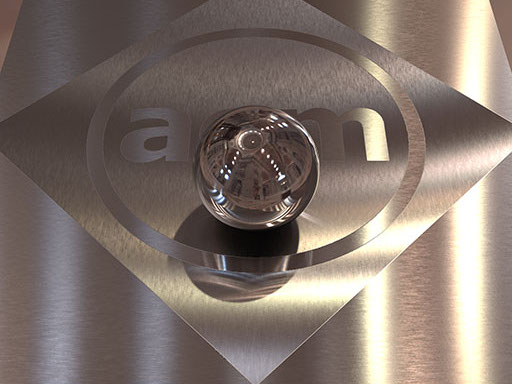
Predicting Appearance from Measured Microgeometry of
Metal Surfaces
The visual appearance of many materials is created by
micro-scale details of their surface geometry. In this
paper, we investigate a new approach to capturing the
appearance of metal surfaces without reflectance
measurements, by deriving microfacet distributions directly
from measured surface topography. Modern profilometers are
capable of measuring surfaces with sub-wavelength resolution
at increasingly rapid rates. We consider both wave- and
geometric-optics methods for predicting BRDFs of measured
surfaces and compare the results to optical measurements
from a gonioreflectometer for five rough metal samples.
Surface measurements are also used to predict spatial
variation, or texture, which is especially important for the
appearance of our anisotropic brushed metal samples.
Profilometer-based BRDF acquisition offers many potential
advantages over traditional techniques, including speed and
easy handling of anisotropic, highly directional materials.
We also introduce a new generalized normal distribution
function, the ellipsoidal NDF, to compactly represent
non-symmetric features in our measured data and texture
synthesis.
The project
page has links to download the paper (ACM Transactions
on Graphics 2015) and related materials, now updated with
the measured data and ellipsoid importance sampling. |
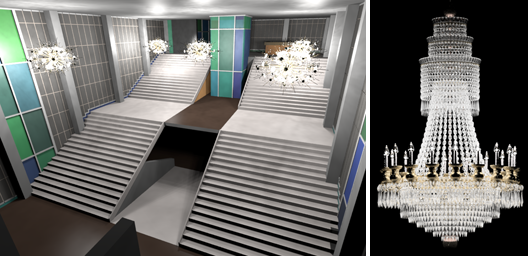
Complex Luminaires: Illumination and Appearance
Rendering
Simulating a complex luminaire, such as a chandelier, is
expensive. Prior approaches cached information on an
aperture surface that separates the luminaire from the
scene, but many luminaires have large or ill-defined
apertures leading to excessive data storage and inaccurate
results. In this paper, we separate luminaire rendering into
illumination and appearance components. A precomputation
stage simulates the complex light flow inside the luminaire
to generate two data structures: a set of anisotropic point
lights (APLs) and a radiance volume. The APLs represent the
light leaving the luminaire, allowing its near- and
far-field illumination to be efficiently computed at render
time. The luminaire's appearance consists of high- and
low-frequency components which are both visually important.
High-frequency components are computed dynamically at render
time, while the more computationally expensive low-frequency
components are approximated using the precomputed radiance
volume.
You can download the
paper (PDF, ACM Transactions on Graphics 2015) here.
|
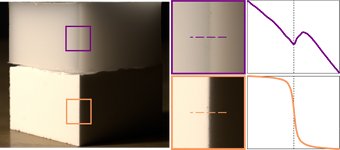
On the Appearance of Translucent Edges
This project investigated the visual appearance of edges on
translucent objects: how they differ from opaque edges, what
causes their unusual features, and how it relates to
material properties.
The project
page has links to download the paper (CVPR 2015) and
related materials. |
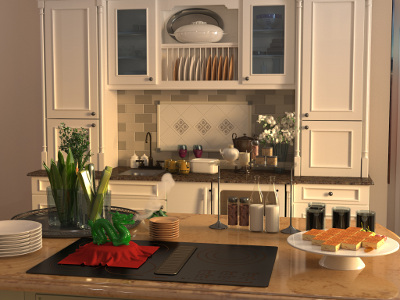
Bidirectional Lightcuts
Scenes modeling the real-world combine a wide variety of
phenomena including glossy materials, detailed heterogeneous
anisotropic media, subsurface scattering, and complex
illumination. Predictive rendering of such scenes is
difficult; unbiased algorithms are typically too slow or too
noisy. Virtual point light (VPL) based algorithms produce
low noise results across a wide range of
performance/accuracy tradeoffs, from interactive rendering
to high quality offline rendering, but their bias means that
locally important illumination features may be missing. We
introduce a bidirectional formulation and a set of weighting
strategies to significantly reduce the bias in VPL-based
rendering algorithms. Our approach, bidirectional
lightcuts, maintains the scalability and low noise
global illumination advantages of prior VPL-based work,
while significantly extending their generality to support a
wider range of important materials and visual cues. We
demonstrate scalable, efficient, and low noise
rendering of scenes with highly complex materials
including gloss, BSSRDFs, and anisotropic volumetric
models.
You can download a SIGGRAPH
2012 preprint paper (pdf) here.
The SIGGRAPH presentation slides are available in keynote format or as
exports to pdf and powerpoint.
|
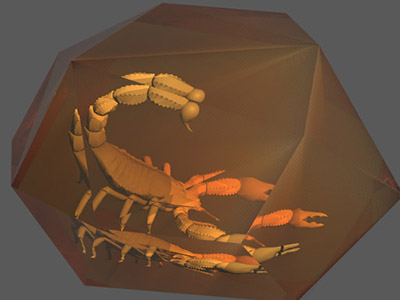
Single Scattering in Refractive Media with Triangle Mesh
Boundaries
Light scattering in refractive media is an important optical
phenomenon for computer graphics. While recent
research has focused on multiple scattering, there has been
less work on accurate solutions for single or low-order
scattering. Refraction through a complex boundary
allows a single external source to be visible in multiple
directions internally with different strengths; these are
hard to find with existing techniques. This paper presents
techniques to quickly find paths that connect points inside
and outside a medium while obeying the laws of refraction.
We introduce a half-vector based formulation to support the
most common geometric representation, triangles with
interpolated normals; hierarchical pruning to scale to
triangular meshes, a solver with strong accuracy guarantees,
and a faster method that is empirically accurate. A
GPU version achieves interactive frame rates in several
examples.
You can download a
SIGGRAPH 2009 preprint paper (pdf) and a quicktime movie
here.
The presentation slides are available in keynote, pdf, or powerpoint + movies formats.
|

Fast Agglomerative Clustering
This paper describes how to build binary trees using
agglomerative (or bottom-up) construction quickly and
evaluates the quality of the trees compared to divisive (or
top-down) construction in two applications: BVH trees for
ray tracing and light trees for Lightcuts. We
introduce a novel faster unordered agglomerative clustering
algorithm for use when the clustering function is
non-decreasing. Our results indicate that the
agglomerative-built trees generally have higher quality
though the build times are a little slower than the fastest
divisive approaches.
You can download a preprint
of the IRT08 paper (pdf) here.
The presentation slides are available in powerpoint and pdf formats.
| Several people asked if a
divisive builder that tries splits on all three
axes rather than just the longest one would make a
significant difference. I tried this and SAH
estimated cost results (see figure 6) are shown in
this table. The quality improved at the cost
of slower builds but still does not match the
agglomerative quality. The maximum depth of
each BVH is shown in paranthesis () with
agglomerative trees tending to be a little deeper
than the divisive ones. |
Model
|
Kitchen
|
Tableau
|
GCT
|
Temple
|
Divisive - 1 axis
|
(32)
46.1
|
(31) 17.7
|
(35) 70.5
|
(42) 29.4
|
Divisive - 3 axis
|
(30) 43.5
|
(29) 17.4
|
(33) 62.7
|
(41) 28.2
|
Agglomerative
|
(60) 36.1
|
(39) 15.5
|
(44) 54.0
|
(65) 22.6
|
|
|
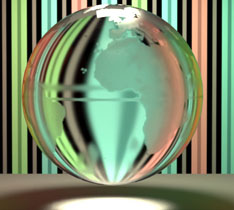
Microfacet Refraction
This work extends microfacet theory (eg, Cook-Torrance
models) to handle refraction through rough surfaces such as
etched glass globe shown. We also discuss the Smith
shadowing-masking approximation for general microfacet
distributions and good importance sampling strategies (which
is essential when simulating transmitted light). Published
at EGSR 2007. You can download
the EGSR 2007 paper (pdf) here.
Erratum: Fixed typo in equation 40 (eta should be
eta^2 inside the square root)
|
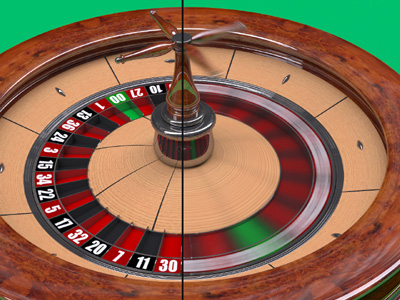
Multidimensional Lightcuts
This work extends the approach and concepts of Lightcuts to
scalable rendering of complex effects such as motion blur,
depth of field, and volume rendering. We achieve greater
scalability by holistically considering complete pixel
integrals and using an implicit hierarchy called the product
graph.
You can download the SIGGRAPH 2006 paper
(pdf) and a movie from the
The SIGGRAPH presentation slides are available in powerpoint or pdf formats, and a separate
archive of clips on the movies page. (Note: the powerpoint file was
created on a Macintosh computer and some of the graphs do
not seem to display properly under Windows.)
|

Lightcuts: A Scalable Approach to Illumination
Computing the illumination from complex sources such as area
lights, HDR environment maps, and indirect, can be very
expensive. Lightcuts introduces a new scalable
algorithm for computing the illumination from thousands or
millions of point lights. Using a perceptual metric, a
binary light tree of clusters, and conservative per-cluster
error bounds, we show that we can accurately compute the
illumination from hundreds of point lights using only
hundreds of shadow rays. A lightcut is cut through the
global light tree that adaptively partitions the lights into
clusters to locally control the cost vs. error
tradeoff. We also introduce a related technique called
reconstruction cuts that uses the lightcut framework to
further reduce shading costs by intelligently interpolating
illumination while preserving high frequencies details like
shadow boundaries and glossy highlights.
You can download the SIGGRAPH 2005
paper (pdf) (Note:
several figures were printed incorrectly in the
proceedings but are correct in the PDF) and a movie
from the
The SIGGRAPH presenation slides are available in powerpoint or pdf formats.
A related technical report
discusses several important implementation issues for the
Ward BRDF including the correct sampling weights that should
be used when using it associated Monte Carlo sampling
distribution.
|
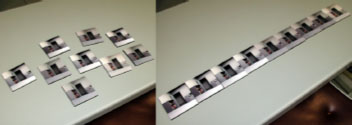
Perceptual Illumination Components
Different components of global illumination have widely
varying costs, but may not provide the same benefits to
image quality. We performed a user study to examine this
issue. We divided the illumination into several components
based on the BRDF (indirect diffuse, indirect gloss,
indirect specular), rendered images with different subsets
of the illumination. We then had people rank the images and
studied the results. What we found is the components had
differing affects on user-ranking (though indirect diffuse
was usually the most important), but that we could predict
their importances quite accurately using a simple model and
some simple image/material statistics. We think this can
provide insight for creating more efficient rendering
systems in the future.
Published in SIGGRAPH 2004. More information can be found on the first
author's page. |

Feature-Based Textures
By adding explicit features (eg, discontinuity edges) to a
standard raster-based textures, we can increase image
quality, especially during magnification, with only minimal
extra storage. Features can be automatically extracted
from vector format images, approximated for raster images,
or hand annotated.
Published in EGSR 2004. More information can be found on this
project page. |

Combining Edges and Points
By combining edges (explicit discontinuities) and points
(shading samples), we are able to reconstruct high quality
images from relatively sparse data. By computing the exact
locations of discontinuities, we are able to interpolate the
sparse data without smoothing out these sharp features and
we also show that knowing the subpixel location of the edges
allows to compute good quality anti-aliasing almost for free
and without supersampling. Our software implementation runs
at interactive rates on the CPU and future versions should
be able to exploit the GPU for even faster framerates.
Published SIGGRAPH 2003. More information can be found on this project
page.
A
GPU-based version was published at Graphics Interface
2006. |
Render Cache for Interactive Rendering
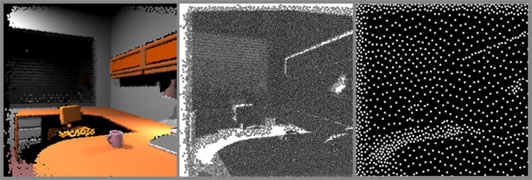
During an interactive session it is not necessary (and perhaps not
even desirable) to render every pixel of every frame.
Especially when using more expensive rendering methods such as
global illumination. In most cases, there is considerable
coherence from one frame to the next which we can exploit to reduce
our computational expense. Also, in an interactive session,
small visual artifacts are acceptable as long as they are small,
fixed quickly, and do not distract the user. In rendering
methods such as ray tracing or global illlumination, the cost of
renderering a pixel various greatly depending on various factors
such as material, local geometry, and complexity of the local
lighting. Thus rerendering every pixel would make the
framerate either highly variable which is far more objectionable in
an interactive session than having some minor visual artifacts would
be.
The render cache enables interactive display by caching rendered
results as colored 3D points, reprojecting them to estimate the
current image, and automatically deciding which subset of pixels
should be (re)rendered for future frames. Because the image
generation and pixel (or ray) rendering happen asynchronously, we
can guarantee a fast consistent framerate regardless of rendering
cost (though renderering cost does affect visual quality).
In our experiments we have found that we get very good visual
quality when only one tenth the pixels are rendered per frame and
acceptable quality when only one hundreth of the pixels are
renderered per frame (the rest of the pixels are estimated by
reprojecting older results).
This work was begun while I was a post-doc at the iMAGIS lab in
Grenoble, France and continued at Cornell.
You can view a project page here
(including a link to the Eurographics Rendering Workshop '99 paper ). (Powerpoint presentation)
A followup paper, Enhancing
and
Optimizing the Render Cache, appeared in EGRW 2002. (Powerpoint presentation)
A
GPU-based version was published at Graphics Interface 2006.
There is also a
web-downloadable binary so that you can try it out for
yourself or download the C++ source code under GPL license and
compile it yourself.
Using Perceptual Texture Masking for Efficient Image Synthesis

This work described a simple and fast way to precompute the
perceptual masking ability of textures (stored as threshold
elevation factors) and store them with the texture. This
allows them to be used during interactive computations to allow
higher error thresholds in textured regions with almost no runtime
overhead.
Published at Eurographics 2002. You
can get the paper here.
Density Estimation for Global Illumination
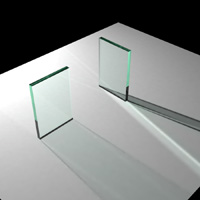
I investigated particle tracing and density estimation as a method
to compute radiosity solutions on large environments. Traditional
radiosity methods have been limited by their large memory
requirements. The density estimation method uses much less memory
because it can efficiently use secondary storage (e.g. disk) for
most its storage needs. It can handle all transport paths (arbitrary
BRDF) and it nicely decomposes the global illumination problem into
three pieces: particle tracing, density estimation, and mesh
decimation.
You can get my thesis here
.
You can get our Transactions on Graphics 1997 paper here
.
You can get our Eurographics Rendering Workshop '95 paper here
.
Fitting Virtual Lights for Non-Diffuse Walkthroughs
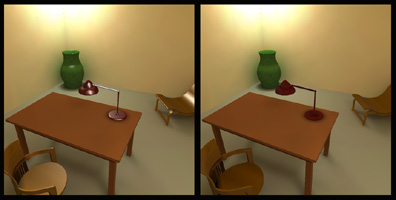
The essence of this work is to find ways to encode non-diffuse
illumination solutions for rapid display using standard 3D graphics
interfaces (e.g. OpenGL) and hardware. We want to be able to
use a sophisticated lighting algorithm such as global illumination
with arbitrary material properties, but we also want to be able to
display the results quickly enough for interactive
walkthrough. Current realtime graphics interfaces and hardware
only implemented a relatively primitive local shading model.
Phong shading and perhaps some shadows are about the limit of their
abilities. We investigate the us of these basic primitives as
a set of "appearance basis" functions that can be used to
approximate the appearance computed by some more accurate, complete,
and general model.
You can get our SIGGRAPH '97 paper
here .
Path-Buffer
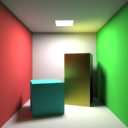

The path-buffer is a modified z-buffer with two z values per
pixel. The extra z value allows us to use the the path-buffer and
scan conversion to trace rays in a path tracing style algorithm.
This reformulated algorithm is designed to be easy to accelerate
using scan conversion and z-buffer type hardware. More details can
be found in:
- "The Path-Buffer" - Technical Report PCG-95-4
- Bruce Walter and Jed Lengyel
Here are pdf versions of the technical
report and figures.
I implemented the path-buffer on the simulator for UNC's PixelFlow
machine as proof of concept with the goal of interactive path
tracing in simple environments. But then I got distracted by
working on my dissertation and have not worked on the path buffer
since.
Other projects
Iterative Adaptive Sampling
- "Accurate Direct Illumination Using
Iterative Adaptive Sampling" - IEEE TVCG June 2006
- Michael Donikian, Bruce Walter, Kavita Bala, Sebastian
Fernandez, and Donald P. Greenberg
Analyzing Ray Casting and Particle Tracing
Rays are used as a primitive in many different rendering algorithms,
but unfortunately the costs of ray casting are not very well
understood. In order to better understand the costs of the particle
tracing phase of our density estimation radiosity algorithm, we are
working on analyzing the costs of ray casting and the variance of
particle tracing.
- "Cost Analysis of a Monte Carlo Radiosity Algorithm" -
Technical Report PCG-95-3
- Bruce Walter and Peter Shirley
I don't have the source for the original report anymore, but here is
a pdf version of an updated, though not quite finished, version of
this technical report.
Email errors, corrections, or comments to "bruce.walter AT
cornell.edu"
Back to my home
page
Back to the Cornell
Program of Computer Graphics










